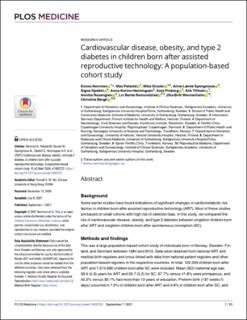| dc.description.abstract | Background
Some earlier studies have found indications of significant changes in cardiometabolic risk factors in children born after assisted reproductive technology (ART). Most of these studies are based on small cohorts with high risk of selection bias. In this study, we compared the risk of cardiovascular disease, obesity, and type 2 diabetes between singleton children born after ART and singleton children born after spontaneous conception (SC).
Methods and findings
This was a large population-based cohort study of individuals born in Norway, Sweden, Finland, and Denmark between 1984 and 2015. Data were obtained from national ART and medical birth registers and cross-linked with data from national patient registers and other population-based registers in the respective countries. In total, 122,429 children born after ART and 7,574,685 children born after SC were included. Mean (SD) maternal age was 33.9 (4.3) years for ART and 29.7 (5.2) for SC, 67.7% versus 41.8% were primiparous, and 45.2% versus 32.1% had more than 12 years of education. Preterm birth (<37 weeks 0 days) occurred in 7.9% of children born after ART and 4.8% in children born after SC, and 5.7% versus 3.3% had a low birth weight (<2,500 g). Mean (SD) follow-up time was 8.6 (6.2) years for children born after ART and 14.0 (8.6) years for children born after SC. In total, 135 (0.11%), 645 (0.65%), and 18 (0.01%) children born after ART were diagnosed with cardiovascular disease (ischemic heart disease, cardiomyopathy, heart failure, or cerebrovascular disease), obesity or type 2 diabetes, respectively. The corresponding values were 10,702 (0.14%), 30,308 (0.74%), and 2,919 (0.04%) for children born after SC. In the unadjusted analysis, children born after ART had a significantly higher risk of any cardiovascular disease (hazard ratio [HR] 1.24; 95% CI 1.04–1.48; p = 0.02), obesity (HR 1.13; 95% CI 1.05–1.23; p = 0.002), and type 2 diabetes (HR 1.71; 95% CI 1.08–2.73; p = 0.02). After adjustment, there was no significant difference between children born after ART and children born after SC for any cardiovascular disease (adjusted HR [aHR]1.02; 95% CI 0.86–1.22; p = 0.80) or type 2 diabetes (aHR 1.31; 95% CI 0.82–2.09; p = 0.25). For any cardiovascular disease, the 95% CI was reasonably narrow, excluding effects of a substantial magnitude, while the 95% CI for type 2 diabetes was wide, not excluding clinically meaningful effects. For obesity, there was a small but significant increased risk among children born after ART (aHR 1.14; 95% CI 1.06–1.23; p = 0.001). Important limitations of the study were the relatively short follow-up time, the limited number of events for some outcomes, and that the outcome obesity is often not considered as a disease and therefore not caught by registers, likely leading to an underestimation of obesity in both children born after ART and children born after SC.
Conclusions
In this study, we observed no difference in the risk of cardiovascular disease or type 2 diabetes between children born after ART and children born after SC. For obesity, there was a small but significant increased risk for children born after ART. | en_US |

